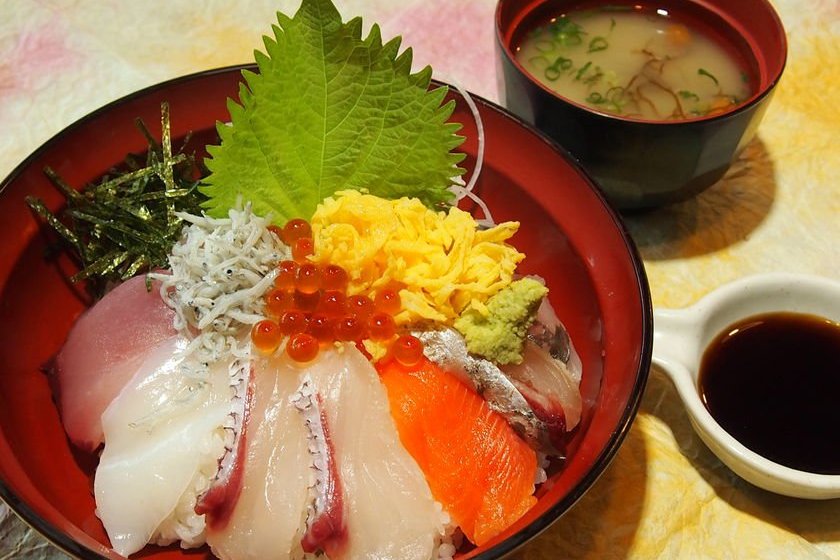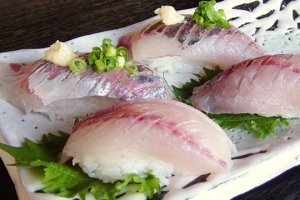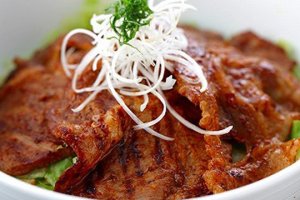Hagi City, located in Yamaguchi Prefecture, is a coastal area popular for its natural charm and preserved cultural heritage.
Here, you can step into the past in the city’s castle town, explore the preserved remains of Hagi’s once booming industries, admire picturesque nature, and much more. In fact, with all the sightseeing, you will likely work up an appetite. Fortunately, alongside Hagi City’s rich legacy are a number of culinary delicacies that are guaranteed to satisfy your taste buds.
Given its location on the Sea of Japan, Hagi City is blessed with an abundance of fresh fish year-round, making it a hotspot for exquisite seafood. The city is also famous for its high quality beef and pork, as well as its succulent summer oranges.
Listed below are our top picks for local cuisine in Hagi City. Be sure not to miss out on these regional delights!
Setsuki Aji

Starting with the ocean’s blessings, Setsuki Aji is a type of horse mackerel located in the waters around Yamaguchi Prefecture. Thanks to their nourishing diet, these fish are characterized by their high fat content, soft texture, and mellow sweetness. You can enjoy them salt-grilled, raw (in the form of sashimi and sushi), fried, and more! As Hagi City is one of the main fishing ports for Setsuki Aji, you can expect exceedingly fresh and high quality dishes.
In season from April to August
Kensaki Squid

Kensaki Squid, called swordtip squid in English, is another seafood staple in Hagi City. This squid is best recognized for its nearly translucent appearance, which, coupled with Japan’s aesthetic presentation of food, creates a beautiful visual. Simultaneously chewy and tender, the squid has a mild sweet flavor and is typically served raw as sashimi or sushi, boiled, or fried as tempura. Each interpretation is equally delicious. Try them all, and choose your favorite.
In season from July to November
Raw Sea Urchin

Hagi City is one of Japan’s leading producers of red sea urchins, called aka uni in Japanese. These small delicacies are typically sweeter than other sea urchin varieties and are renowned for their complex depth of flavor and creamy, melt-in-your-mouth texture. One of the best ways to enjoy these special sea urchins is with a sea urchin rice bowl (uni don). The rice’s gentle aroma perfectly complements the umami-rich notes of the sea urchins.
In season from spring to summer
Kenran Beef

Hagi City’s delectable cuisine does not stop at seafood and encompasses some of the country’s most mouth-watering meat—Kenran beef. Mishima Island cows, the beef’s source, are a cross between indigenous island cows and the Netherlands’ Holstein breed and are designated as a Natural Monument. The resulting high-grade beef has exquisite marbling with a rich flavor profile and tender texture. Let the decadent flavors of Kenran beef shine by enjoying it grilled or even raw!
You can enjoy it year-round
Mutsumi Pork

Alongside its luscious beef, Hagi City is also home to high-quality pork called Mutsumi pork. These pigs are raised in stress-free environments and are fed a special diet that primarily consists of dried bread crumbs. Given their careful upbringing, the yielding pork is soft and juicy with a subtle sweetness. Try this meat as a fried pork cutlet, katsudon (fried pork cutlet with egg over rice), curry, and more.
You can enjoy it year-round
Summer Oranges

Summer oranges, called natsumikan in Japanese, have long been a staple in Hagi City’s gastronomy. Once Japan abolished its feudal system in the late 1800s, many samurai were left without jobs. To solve their economic hardships Hagi’s ex-samurai turned to planting summer oranges. These orange trees still exist throughout Hagi City today and fill the castle town with their sweet, citrusy fragrance every May. Hagi’s summer oranges are characterized by their slight bittersweetness, sourness, and juiciness—making for the perfect summer treat. Enjoy the iconic citrus flavor in the form of juice, ice cream, gelatin desserts, sweets, jelly, and candied treats. The summer oranges are a popular souvenir from Hagi!
In season from April to June
Hotoritei Cafe

Hotoritei Cafe, with its traditional atmosphere and delicious cuisine, acts as the perfect addition to your exploration of Hagi’s castle town. Located in a building reminiscent of the past, Hotoritei Cafe serves both Japanese and Western dishes and has a beautiful Japanese garden that you can admire from wide windows as you enjoy your meal. Open for lunch (11am–4pm), the cafe serves savory meals such as hamburger steak, fish-of-the-day, and hashed beef, as well as pancakes topped with an assortment of sweet toppings. In terms of drinks, the cafe offers a variety of coffee, tea, juice, and beer. The nourishing meals, coupled with the cafe’s traditional, yet chic vibes, create a relaxing dining experience you will not soon forget.
Access to Hagi City
The most common ways to access Hagi City are via plane, Shinkansen, and express bus. The two closest airports to Hagi City are Yamaguchi Ube Airport and Hagi Iwami Airport. Flights to these airports depart from Tokyo Haneda Airport on a daily basis and take about 95 minutes. From the airports, Hagi City is 70 to 80 minutes away via a direct taxi service (reservations required) or rental car. There are also numerous bus options available.
For the Shinkansen, JR Shin-Yamaguchi Station is the closest Shinkansen station to Hagi City. Shin-Yamaguchi Station is on the main Sanyo Shinkansen line and is four hours and 30 minutes from Tokyo, two hours from Osaka, 32 minutes from Hiroshima, and 35 minutes from Fukuoka. Once you reach JR Shin-Yamaguchi Station, you can take a bus to Hagi City, which takes between 70 and 90 minutes.
Lastly, you can reach Hagi City via an express bus from Tokyo Station, Kyoto Station, Shin-Osaka Station, and Sannomiya Bus Terminal in Kobe. These journeys take about 14 hours and 30 minutes, 13 hours and 15 minutes, 12 hours and 20 minutes, and 10 hours and 45 minutes respectively.




































